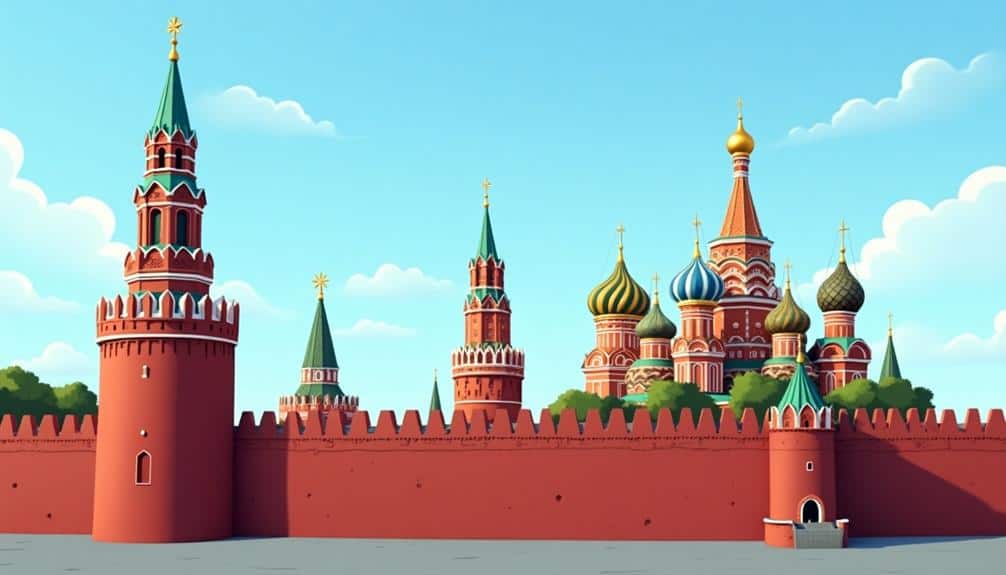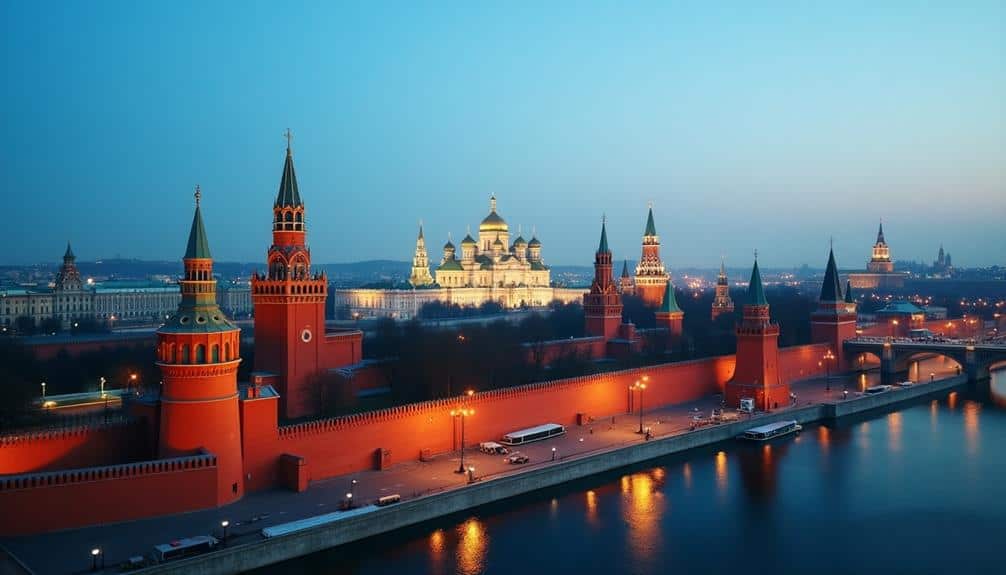The term “Kremlin” in Russia, translating to “fortress,” encapsulates the essence of fortified complexes that have historically served as the epicenter of political and cultural life in major cities. While the Moscow Kremlin is the most renowned, showcasing grandiose architecture and significant historical artifacts, other Kremlins like those in Kazan and Novgorod each tell their own unique stories. These structures are not merely relics of the past but continue to function as vital hubs of governance and cultural identity. What layers of historical and modern significance do these iconic fortresses hold?
Definition and Meaning of “Kremlin”

A kremlin, derived from the Russian word “кремль,” meaning fortress or citadel, serves as a fortified central complex found in many historical cities across Russia. Kremlins represent significant aspects of both historical and contemporary Russian life.
Kremlin history dates back to medieval times when these fortresses were built to protect against invasions and to serve as administrative centers. The architecture of a kremlin typically features imposing walls, towers, and gateways, often incorporating churches, palaces, and government buildings within its enclosure.
The symbolism of the kremlin extends beyond its physical structure; it embodies the strength and resilience of Russian statehood. Over the centuries, these complexes have been centers of governance, where essential political decisions were made and where leaders resided.
Today, the Moscow Kremlin remains a powerful symbol of Russian governance, housing the official residence of the President of Russia.
Additionally, kremlins play an important role in Kremlin tourism, attracting millions of visitors annually. Tourists flock to these historic sites to explore their rich heritage and to witness firsthand the architectural marvels that have stood the test of time.
Consequently, kremlins are not only historical fortresses but also dynamic symbols of Russia’s enduring legacy.
Kremlin Variations in Different Russian Cities
Kremlins are not unique to Moscow; they are a prominent feature in many historical cities across Russia, each with its own distinct characteristics and historical significance.
These regional kremlins, while sharing a common purpose of fortification, exhibit unique architectural styles that reflect the cultural variations of their respective locales.
For instance, the Kazan Kremlin showcases a blend of Russian and Tatar architectural elements, underscoring the city’s diverse cultural heritage. Its white-stone walls and the iconic Kul Sharif Mosque highlight the region’s historical significance.
Similarly, the Novgorod Kremlin, one of the oldest in Russia, features medieval Russian architecture and has played a pivotal role in the country’s political and religious history.
In Pskov, the kremlin, known as the Pskov Krom, is renowned for its robust fortifications and its influence on regional architecture.
Each kremlin also serves as a potent symbol of political power; the Tula Kremlin, for example, stands proof of the city’s military importance during various historical conflicts.
Notable Structures within the Kremlin

What makes the Kremlin a focal point of Russian history and culture? Among its most notable structures, the Grand Kremlin Palace stands out. Originally constructed as a royal residence, this monumental edifice exemplifies Kremlin architecture, melding classical Russian and Renaissance styles.
Today, it serves as the official residence of the President of Russia, embodying political symbolism and historical influences that span centuries.
The Cathedral of the Assumption is another cultural landmark within the Kremlin. Built in the late 15th century, this cathedral has witnessed the coronation of Russian tsars and patriarchs. Its interior frescoes and iconostasis are reflections of the religious and artistic heritage of Russia, offering visitors an immersive experience of the nation’s spiritual history.
Other significant religious structures include the Archangel and Annunciation Cathedrals, each contributing to the Kremlin’s rich tapestry of historical influences. These edifices serve not only as places of worship but also as repositories of Russian culture and history.
For visitors, the Kremlin offers a multifaceted experience that combines awe-inspiring architecture, deep-rooted historical narratives, and a palpable sense of political symbolism, making it a must-visit cultural landmark in Russia.
Modern Usage and Cultural Significance
Frequently regarded as the heart of Russian political power, the Kremlin continues to function as a significant symbol of the nation’s governance and cultural identity. The Kremlin’s symbolism extends beyond its massive walls and ornate towers; it represents the nexus of political representation in Russia, housing the official residence of the President and various government offices. This embodiment of state authority underscores the historical significance of the fortress, which has been the epicenter of Russian power for centuries.
Moreover, the Kremlin is a repository of Russia’s rich cultural heritage. Its array of cathedrals, palaces, and museums showcases architectural marvels and historical artifacts, offering a window into the nation’s storied past.
Tourist experiences within the Kremlin compound are meticulously curated to highlight its dual role as a living political center and a cultural treasure trove. Visitors from around the globe flock to explore its grandeur, making it one of Russia’s premier tourist attractions.




